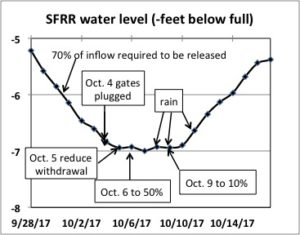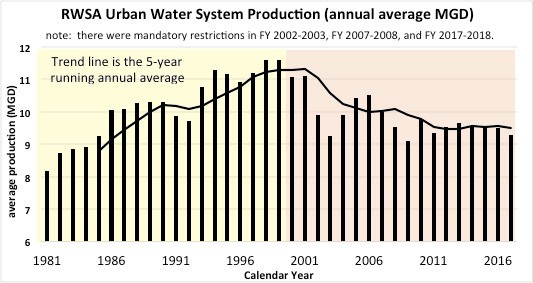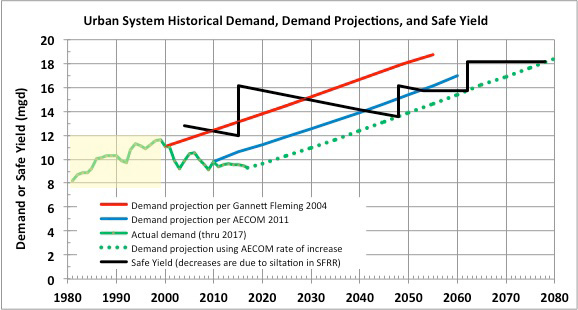This website was developed to present to the Charlottesville community a factual and reasoned analysis of the community water supply plan for meeting future public water supply needs. The website was developed by Richard W. Gullick, PhD, former Director of Operations for the Rivanna Water and Sewer Authority. Dr. Gullick may be contacted here
Introduction
The Rivanna Water and Sewer Authority (RWSA), the area’s wholesale water utility, has been pushing for construction of an unnecessary and extremely expensive ($82 million) pipeline project many decades before their engineering analyses show it would be needed. Basically, RWSA is trying to solve a problem that simply doesn’t exist. Even worse, as part of that push, RWSA has been presenting a tremendous amount of misinformation to other public officials and the community in an effort to rally support for the project. RWSA is apparently being controlled by political pressures and motivations, and not by sound science and engineering practices.
A summary of the issues surrounding the pipeline project may be found [bsk-pdf-manager-pdf id=”6″]
The Issue
In 2001-2002, the Central Virginia Region experienced an historical drought of record. This drought and the water supply needs of the Charlottesville/Albemarle region sparked a decade-long water supply planning process (2002-2012). The process led to the approved and permitted Community Water Supply Plan (CWSP) for addressing long-term water supply demand (a 50-year plan).
The CWSP included five main components:
- build a new Ragged Mountain Reservoir Dam to greatly expand capacity, and allow filling to 1.5 billion gallons of the total 2.1 billion gallon capacity;
- conduct periodic updates to the demand projection and safe yield studies;
- complete the filling of the Ragged Mountain Reservoir the final 600 million gallons;
- dredge the South Fork Rivanna Reservoir to increase storage capacity; and,
- construct a “proposed” pipeline and associated infrastructure to move water between the South Fork Rivanna Reservoir (SFRR) and the Ragged Mountain Reservoir (RMR).
Dredging SFRR has since been deemed unfeasible. The following table compares the two remaining options for increasing water supply safe yield (filling the Ragged Mountain Reservoir the final 12 feet is over 110 times more cost effective than building the pipeline, and can be completed 12 times faster).
Comparison of RWSA’s Community Water Supply Plan Options for Increasing Safe Yield1
| Method | Added Safe Yield | Added storage capacity | Years of demand growth satisfied2 | Estimated Cost | Time to complete | Cost per gpd of safe yield |
|---|---|---|---|---|---|---|
| Finish filling Ragged Mountain Reservoir | 2.6 mgd | 600 MG | 18.1 (11.7) | < $1 million | < 1 year | $0.31 |
| SFRR-RMR pipeline project | 2.4 mgd | 0 | 16.7 (10.8) | $82 million | 12 years | $34.2 |
| Notes: | 1 Assumes that the water level in Ragged Mountain Reservoir is raised before the pipeline is built. 2 Demand growth predicted by AECOM 2011 to average 0.144 mgd per year. Siltation in the South Fork Rivanna Reservoir is expected to decrease the total system safe yield over time until its volume is reduced to approximately 200 MG in about 2053, and then no further volume loss is expected. The first values assume no loss of safe yield due to SFRR siltation (i.e., after 2053), and the values in parentheses include the loss of safe yield due to siltation in SFRR (i.e., before 2053). |
|||||
The main question right now is when the pipeline should be built. RWSA officials are saying the pipeline is needed relatively soon, long before the engineering analyses actually show it would be needed. Up through 1999 water demand in the Charlottesville community was increasing rapidly, and the CWSP was based on future demand projections using that same historical rate of increase. However, water demand has decreased significantly since then, but RWSA has not taken that into account in their scheduling of the pipeline project. In fact, RWSA’s data and engineering analyses show that the pipeline is NOT needed anytime soon, and won’t be needed until well after 2062! Furthermore, RWSA has been pushing for a decision on the timing of the project in 2018, instead of waiting until the next year or two (2019-2020) when an update to the demand projection and safe yield study will be completed.
Another aspect of RWSA’s misinformation campaign is that they insist that the pipeline should be built to avoid another repeat of the Fall 2017 mandatory water restrictions. Those restrictions were caused by RWSA’s mismanagement of the South Fork Rivanna Reservoir, as the water level dropped rapidly in August and September 2017 as a result of two gates in the dam leaking tremendous amounts of water out of the reservoir and into the river downstream. RWSA continues to try to cover up this fact. The loss of water was caused by the leaking gates, not by the weather! At the end of September 2017, the reservoir was losing about 17.5 million gallons a day. That drop stopped when the gates were sealed by dumping garden mulch and cat litter into the leaking valves. Additional efforts by RWSA over the next few days were relatively minor compared to the leaking gates (e.g., they reduced withdrawals for treatment by 2.6 mgd, and saved about 2.5 mgd by reducing the amount of water released downstream).

For more information on the fiasco of the unnecessary mandatory water restrictions, see [bsk-pdf-manager-pdf id=”11″]
or item # 3 in [bsk-pdf-manager-pdf id=”6″]
To learn more about the rest of RWSA’s misinformation campaign about the pipeline, [bsk-pdf-manager-pdf id=”7″]
Why It’s Not Needed Now, and When Will It Be Needed? [bsk-pdf-manager-pdf id=”6″]
Community Water Supply Plan Options, and RWSA’s Five Proposed Schedule Options for the Pipeline Project:
In 2001-2002, the Central Virginia Region experienced an historical drought of record. This drought and the water supply needs of the Charlottesville/Albemarle region sparked a decade-long water supply planning process (2002-2012). The process led to the now permitted Community Water Supply Plan (CWSP). The CWSP is not one document, and instead is comprised of several documents, agreements, and plans.
The CWSP involves five main components for addressing future needs for additional water supply:
- A new dam was constructed at the Ragged Mountain Reservoir, increasing storage capacity by over 1,600 million gallons (MG) to a total of ~2,100 million gallons (MG). The reservoir was not filled all of the way, however, as some of the trees were left in place, and an additional 12 feet (600 million gallons) still remains available to easily add additional water storage capacity as demand needs dictate in the future. The dam was completed in 2014, and was filled to the current 1,513 MG capacity level by early 2016.
- The demand projections and safe yield estimates are to be updated at least every 10 years. This is to be done in order to provide information for deciding when additional water supply would be needed.
- At a time to be decided later, complete the filling of Ragged Mountain Reservoir the final 12 feet (600 million gallons).
- At a time to be decided later, dredge the South Fork Rivanna Reservoir to increase storage capacity; and,
- At a time to be decided later, construct a “proposed” pipeline and associated infrastructure to move water between the South Fork Rivanna Reservoir (SFRR) and the Ragged Mountain Reservoir (RMR), to be constructed at a time to be decided later. This would involve construction and operation of the following at an estimated cost of $82 million (in 2017 dollars):
- A 9-mile-long, 36-inch diameter pipeline with the capacity to transfer 25 million gallons per day (mgd) of water from SFRR to RMR, or transfer 16 mgd from RMR to the South Rivanna Water Treatment Plant (WTP).
- A new 25-mgd water treatment plant to remove sediment and nutrients to reduce potential adverse impacts to the quality of water in the Ragged Mountain Reservoir.
- An intake structure and pump station at the SFRR to convey water to that new treatment plant.
- A pump station to move the water uphill from the SFRR to RMR.
- A pump station to move water from RMR to the South Rivanna WTP.
| Method | Added Safe Yield | Added storage capacity | Years of demand growth satisfied2 | Estimated Cost | Time to complete | Cost per gpd of safe yield |
|---|---|---|---|---|---|---|
| Finish filling Ragged Mountain Reservoir | 2.6 mgd | 600 MG | 18.1 (11.7) | < $1 million | < 1 year | $0.31 |
| SFRR-RMR pipeline project | 2.4 mgd | 0 | 16.7 (10.8) | $82 million | 12 years | $34.2 |
| Notes: | 1 Assumes that the water level in Ragged Mountain Reservoir is raised before the pipeline is built. 2 Demand growth predicted by AECOM 2011 to average 0.144 mgd per year. Siltation in the South Fork Rivanna Reservoir is expected to decrease the total system safe yield over time until its volume is reduced to approximately 200 MG in about 2053, and then no further volume loss is expected. The first values assume no loss of safe yield due to SFRR siltation (i.e., after 2053), and the values in parentheses include the loss of safe yield due to siltation in SFRR (i.e., before 2053). |
|||||
- For more information on the Community Water Supply Plan, as well as on RWSA’s proposed schedules for constructing the pipeline project: [bsk-pdf-manager-pdf id=”9″]
- RWSA’s webpage for the Community Water Supply Plan <http://www.rivanna.org/community-water-supply-plan>
Dr. Rich Gullick’s proposed approach to the community water supply plan:
[bsk-pdf-manager-pdf id=”8″]
RWSA’s Misinformation Campaign about the Pipeline Project:
- Fact checking and rebuttal to RWSA’s misinformation [bsk-pdf-manager-pdf id=”7″]
- Gullick’s 6-26-18 written statement to the RWSA Board of Directors [bsk-pdf-manager-pdf id=”5″]
- Gullick’s responses to RWSA’s 4-4-18 claims regarding their reasons for the water restrictions [bsk-pdf-manager-pdf id=”10″]
- Evaluation of factors contributing to the rapid drop in water level in the South Fork Rivanna Reservoir from August 4 through October 5, 2017 [bsk-pdf-manager-pdf id=”11″]
- Gullick’s responses to RWSA’s 4-4-18 claims regarding their reasons for the water restrictions [bsk-pdf-manager-pdf id=”10″]
- Gullick’s responses to RWSA’s “Drought Q&A” [bsk-pdf-manager-pdf id=”12″]
Dr. Gullick’s public statements:
[bsk-pdf-manager-pdf id=”4″]
[bsk-pdf-manager-pdf id=”5″]
[bsk-pdf-manager-pdf id=”1″]
[bsk-pdf-manager-pdf id=”3″]
[bsk-pdf-manager-pdf id=”2″]
News reports:
- 2017-11-07 The Daily Progress – Questions linger on sudden drought warning
- 2018-01-29 TV19 news – Debate over water pipeline start date
- 2018-02-09 C-ville Weekly – The cost of maintaining our water system
- 2018-04-25 The Daily Progress – Birdwood portion of water pipeline moving forward
- 2018-06-19 The Daily Progress- Some concerned by timing of planned RWSA water pipeline
- 2018-06-19 NBC29 – Planned Pipeline to Connect 2 Reservoirs, Protect Against Droughts
- 2018-07-02 C-ville Weekly- Leaky-gate, RWSA employee resigns in protest
- 2018-07-24 NBC29 – RWSA Addresses Public Concerns Regarding Waterline Project
- 2018-07-30 The Daily Progress- Need for new water pipeline hotly debated
- 2018-08-01 C-ville Weekly – Leaky-gate, part 2: RWSA responds to cover-up accusations
- 2018-08-01- The Daily Progress – Opinion/Editorial: Water policy is latest focus of dissension
- 2018-08-05- The Daily Progress- Opinion/Letter: Water pipeline cost too high, benefits too low
RWSA web pages:
- Community Water Supply Plan http://www.rivanna.org/community-water-supply-plan
- SFRR to RMR Pipeline Project http://www.rivanna.org/srr-to-rmr-water-line-project/
- RWSA Board of Directors meetings, agendas, and minutes http://www.rivanna.org/news-and-information/board-meetings/
www.CvilleWater.info – “A citizen’s guide to the water supply”:
- This is a website developed by citizens opposed to Rivanna’s approach and solution for the community water supply plan. Much of this material was posted during development of the community water supply plan through 2012. The website contains a history of the controversial plan, as well as numerous links to related reports, communications, and other documents. cvillewater.info
What can you do?
Contact the following public officials and local newspapers with your opinions:
- Charlottesville City Council <council@charlottesville.org>
- Albemarle County Board of Supervisors <bos@albemarle.org>
- Rivanna Water and Sewer Authority Board of Directors <rwsaboardmembers@rivanna.org>
- Albemarle County Service Authority <board@serviceauthority.org>
- C-ville Weekly <editor@c-ville.com>
- Daily Progress <https://www.dailyprogress.com/site/forms/online_services/letter/letter_editor/>
Who is Dr. Rich Gullick?
- Richard W. Gullick, PhD, is the former Director of Operations for the Rivanna Water and Sewer Authority. He resigned that position in February 2018 in protest of the unethical misinformation campaign regarding the pipeline project being put forth by the top leadership of RWSA.
- While working at RWSA, Dr. Gullick tried repeatedly through internal channels to get the misinformation corrected, but without success (much of that misinformation continues to this day). And he was not allowed to communicate about it with any of the RWSA Board members or the public. The pipeline and overall community water supply plan issues are of tremendous importance to the community. RWSA’s misinformation campaign became so egregious that Dr. Gullick felt it absolutely necessary, for both the public’s welfare and for his own good, to resign his position as RWSA’s Director of Operations in protest, and to then be able to bring forth the truth to the Charlottesville community and its elected officials.
- Gullick’s personal and professional ethics prevented him from remaining silent while public officials and the community were being extremely misled about this ill-timed and wasteful project. Simply put, “Thou shalt not bear false witness against thy neighbor.”
- Gullick has a national reputation as a leader in the drinking water supply field. He earned bachelor’s, master’s, and PhD degrees in environmental science, public health (environmental management and protection), and environmental engineering from some of the top universities in the country. Dr. Gullick has worked directly for three large water utilities, and consulted for many other water utilities such as Philadelphia, Cleveland, and Raleigh. Dr. Gullick is well published in the water resources field, and has been very active in related professional organizations. For example, he currently serves on the Editorial Board of the Journal American Water Works Association, and was the chief developer and author of AWWA’s Standard for Source Water Protection and the accompanying guidebook.
- Gullick’s resume is available [bsk-pdf-manager-pdf id=”13″]
- You can contact Dr. Gullick here.
Website last updated August 2, 2018
This website was developed by Richard W. Gullick, PhD, former Director of Operations for the Rivanna Water and Sewer Authority. If you have any comments, want further information, or want to know the reference sources for any of the information provided, please contact Dr. Gullick here.

